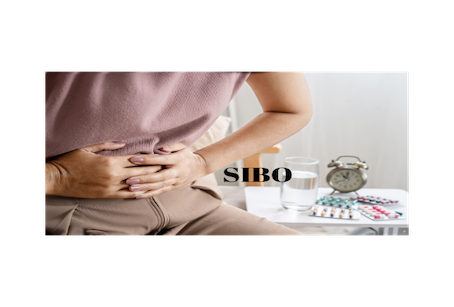
Small Intestine Bacterial Overgrowth (SIBO) is a digestive condition that results from an abnormal increase in the amount of bacteria in your small intestine. It’s hard to say just how prevalent SIBO is because it’s not often tested, though some estimate that it affects 2-25% of people.
Under normal circumstances, the small intestine has relatively few bacteria compared to the large intestine. However, when you have SIBO, there is an overgrowth that can interrupt your normal digestion and cause symptoms, indicating there’s a problem within your gut microbiome (the community of microbes living in your digestive tract).
SIBO is a complex condition. It requires a comprehensive and personalized approach, which can include SIBO natural treatment options.
How to Tell if You Have SIBO
SIBO can be challenging to diagnose on your own given that many of its symptoms can feel nonspecific, meaning that they could indicate more than one condition.
However, here are some of the more commonly reported symptoms of SIBO:
- Bloating
- Abdominal pain
- Increased gassiness
- Changes in bowel movements, including diarrhea or constipation
- Nausea
- Unintentional weight loss
- Unusual tiredness or weakness
- Indigestion or feeling full sooner than normal when eating
Taking these potential symptoms into consideration, there are also a few other indications that you might be dealing with SIBO.
First, your symptoms are persistent and ongoing. Next, you might notice that certain foods make symptoms worse, or that you become more sensitive to foods that are high in fermentable carbohydrates (which we’ll cover later).
Finally, if you have a history of digestive-related conditions, like IBS or Celiac disease, these might be associated with a higher risk of developing SIBO.
Diagnosing SIBO
There’s no gold standard for diagnosing SIBO, but a healthcare provider can help rule out other causes. For example, they can do a physical exam and discuss your medical history and symptoms and then may run tests to confirm SIBO, such as:
- Lactulose Breath Test: Measures hydrogen and methane gases in your breath after eating lactulose, a sugar that bacteria ferment.
- Glucose Breath Test: Measures hydrogen and methane gases in your breath after consuming glucose. This test is often preferred because glucose is absorbed more quickly, giving a better indication of bacterial overgrowth.
- Small Intestinal Aspirate and Culture: This involves taking a sample of fluid from your small intestine and sending it to the lab to identify the presence and quantity of bacteria.
- Stool Tests: While not a primary diagnostic tool, stool tests can provide information about your gut flora and help rule out other conditions.
- Imaging Studies: These may be used to identify any physical abnormalities in your digestive tract that might contribute to SIBO.
If you prefer doing an at-home SIBO test, breath tests are available that can be done in the comfort of your home. These tests can be accurate (assuming they are taken properly), but their results should be interpreted by a healthcare provider.
How to Treat SIBO Naturally: 7 Ways
Okay, so you have SIBO. How should you proceed? One of the most important first steps is to get to the root cause(s). While there’s sometimes a misconception that SIBO is a root cause, often it’s actually a symptom of something else.
To identify potential root causes, it’s important to work with a health practitioner who is knowledgeable about SIBO. Perhaps you’re dealing with the consequences of a fungal/candida overgrowth, a restrictive diet, a nasty bout of food poisoning, or long-term use of hormonal birth control or other prescription medications — but these vary from person to person.
Once you have an idea of what underlying factors may be contributing, it’s time to listen to your gut, so to speak.
The first step of clinical SIBO treatment often involves using antibiotics to stop bacterial overgrowth and replete any nutritional deficiencies, but some people prefer SIBO natural treatment options instead. Below I’ve listed 7 to consider, keeping in mind that there is limited evidence behind their use in SIBO over standard treatments.
1. Low-FODMAP Diet
A low-FODMAP diet is designed to reduce symptoms of irritable bowel syndrome (IBS) and other digestive disorders by limiting foods high in fermentable carbs — oligosaccharides, disaccharides, monosaccharides, and polyols (FODMAPs).
These carbs are poorly absorbed in the small intestine and fermented by bacteria, leading to symptoms like bloating, gas, and diarrhea. By avoiding high-FODMAP foods (like wheat, garlic, onions, cow’s milk, apples, and cauliflower, to name a few) you can reduce bacterial fermentation and related symptoms.
This way of eating may be particularly helpful for managing SIBO because it minimizes the food sources available for the overgrown bacteria. It’s usually followed in phases, starting with elimination and then gradually reintroducing foods to identify triggers.
2. Specific Carbohydrate Diet (SCD)
The SCD restricts complex carbs and sugars, focusing instead on easily digestible, simple carbs. It avoids foods that are difficult for the body to break down (which may be trigger foods for you) to reduce bacterial fermentation in the small intestine.
For example, avoiding starches, grains, and certain sugars can help reduce the food supply for harmful bacteria and reduce symptoms. Instead, you’ll prioritize nutrient-dense foods like fish, vegetables, meats, and specific fruits that promote gut healing and microbial rebalance.
Research on SCD for SIBO is limited. One study concluded that the SCD diet wasn’t any more effective than the Mediterranean Diet (also high in plants and fish but easier to follow for participants) for treating symptoms of Crohn’s disease, another digestive condition.
3. Probiotics
A probiotic is a type of friendly bacteria or yeast that you consume to support and restore the natural balance of your gut microbiome and help good microbes thrive. They’re found in fermented foods (like tempeh, miso, kefir, and sauerkraut) and supplements.
Probiotics may help with SIBO by outcompeting harmful bacteria and supporting a healthier microbial balance. This helps restore gut harmony, improve digestion, reduce inflammation, and potentially alleviate SIBO symptoms.
Certain strains of probiotics, like Lactobacillus and Bifidobacterium, may be most effective for SIBO treatment and overall gut health.
4. Herbal Antimicrobials
Herbal antimicrobials are plant-derived compounds with properties that may inhibit or kill bacteria, fungi, and other harmful germs. Examples include garlic, oregano oil, and berberine, which have actually been studied for their ability to inhibit harmful bacteria.
These may be used in SIBO as a natural alternative to antibiotics and may also have anti-inflammatory benefits for gut health, though the evidence is limited.
5. Digestive Enzymes
Digestive enzymes are proteins that help break down food into smaller, absorbable components in the digestive tract. They’re needed to digest macronutrients (carbs, fat, protein) so they can be utilized by your body.
For people with SIBO, digestive enzyme supplementation may help support digestion, reducing the amount of undigested material available for bacterial fermentation in the small intestine. The intention is that this helps reduce symptoms like bloating, gas, and gut discomfort.
6. Gut Motility Support
“Gut motility” refers to how things are moving through your digestive system (food and waste), which can be impaired when you have SIBO. This results in leftover food and bacteria in the small intestine that may contribute to bacterial overgrowth.
Some examples of gut motility support that could be deployed for SIBO include prokinetic agents, like ginger and low-dose naltrexone. Additionally, lifestyle changes matter, like adhering to regular exercise (which can not only help move things along but also support a healthier bacterial balance).
By doing things that improve the movement of materials through your digestive system can help lower the risk of bacterial fermentation and minimize SIBO symptoms.
7. Stress Management
There’s a well-known relationship between the gut and brain (often called the gut-brain axis), in that there’s a two-way communication constantly occurring between them. As such, mental health challenges like chronic stress can affect your gut health, and may ultimately play a role in SIBO.
This means stress management practices matter for more than just your mental wellness. Finding ways to cope with stressors and become more resilient can also be helpful for your gut microbiome.
Some examples of stress management techniques include:
- Practicing yoga or stretching
- Mindful meditation
- Creative practices like journaling, art, or listening to calming music
- Spending time outside in nature
- Engaging in regular low to moderate-intensity physical activity
Interested in personalized guidance for your gut microbiome? I can help! Click here to explore my services, which include 1:1 consultations as well as online courses (including one on the Low FODMAP Diet).
References
- Sorathia SJ, Chippa V, Rivas JM. Small Intestinal Bacterial Overgrowth. [Updated 2023 Apr 17]. In: StatPearls [Internet]. Treasure Island (FL): StatPearls Publishing; 2024 Jan-. Available from: https://www.ncbi.nlm.nih.gov/books/NBK546634/
- Skrzydło-Radomańska B, Cukrowska B. How to Recognize and Treat Small Intestinal Bacterial Overgrowth?. J Clin Med. 2022;11(20):6017. Published 2022 Oct 12. doi:10.3390/jcm11206017
- Adike A, DiBaise JK. Small Intestinal Bacterial Overgrowth: Nutritional Implications, Diagnosis, and Management. Gastroenterol Clin North Am. 2018;47(1):193-208. doi:10.1016/j.gtc.2017.09.008
- Achufusi TGO, Sharma A, Zamora EA, Manocha D. Small Intestinal Bacterial Overgrowth: Comprehensive Review of Diagnosis, Prevention, and Treatment Methods. Cureus. 2020;12(6):e8860. Published 2020 Jun 27. doi:10.7759/cureus.8860
- Lewis JD, Sandler RS, Brotherton C, et al. A Randomized Trial Comparing the Specific Carbohydrate Diet to a Mediterranean Diet in Adults With Crohn’s Disease [published correction appears in Gastroenterology. 2022 Nov;163(5):1473. doi: 10.1053/j.gastro.2022.07.058]. Gastroenterology. 2021;161(3):837-852.e9. doi:10.1053/j.gastro.2021.05.047
- Soemarie YB, Milanda T, Barliana MI. Fermented Foods as Probiotics: A Review. J Adv Pharm Technol Res. 2021;12(4):335-339. doi:10.4103/japtr.japtr_116_21
- Achufusi TGO, Sharma A, Zamora EA, Manocha D. Small Intestinal Bacterial Overgrowth: Comprehensive Review of Diagnosis, Prevention, and Treatment Methods. Cureus. 2020;12(6):e8860. Published 2020 Jun 27. doi:10.7759/cureus.8860
- Parham S, Kharazi AZ, Bakhsheshi-Rad HR, et al. Antioxidant, Antimicrobial and Antiviral Properties of Herbal Materials. Antioxidants (Basel). 2020;9(12):1309. Published 2020 Dec 21. doi:10.3390/antiox9121309
- Goncagul G, Ayaz E. Antimicrobial effect of garlic (Allium sativum). Recent Pat Antiinfect Drug Discov. 2010;5(1):91-93. doi:10.2174/157489110790112536
- Rodriguez-Garcia I, Silva-Espinoza BA, Ortega-Ramirez LA, et al. Oregano Essential Oil as an Antimicrobial and Antioxidant Additive in Food Products. Crit Rev Food Sci Nutr. 2016;56(10):1717-1727. doi:10.1080/10408398.2013.800832
- Yu HH, Kim KJ, Cha JD, et al. Antimicrobial activity of berberine alone and in combination with ampicillin or oxacillin against methicillin-resistant Staphylococcus aureus. J Med Food. 2005;8(4):454-461. doi:10.1089/jmf.2005.8.454
- Skrzydło-Radomańska B, Cukrowska B. How to Recognize and Treat Small Intestinal Bacterial Overgrowth?. J Clin Med. 2022;11(20):6017. Published 2022 Oct 12. doi:10.3390/jcm11206017
- Nikkhah Bodagh M, Maleki I, Hekmatdoost A. Ginger in gastrointestinal disorders: A systematic review of clinical trials. Food Sci Nutr. 2018;7(1):96-108. Published 2018 Nov 5. doi:10.1002/fsn3.807
- Ploesser J, Weinstock LB, Thomas E. Low dose naltrexone: side effects and efficacy in gastrointestinal disorders. Int J Pharm Compd. 2010;14(2):171-173.
- Sohail MU, Yassine HM, Sohail A, Thani AAA. Impact of Physical Exercise on Gut Microbiome, Inflammation, and the Pathobiology of Metabolic Disorders. Rev Diabet Stud. 2019;15:35-48. doi:10.1900/RDS.2019.15.35
- Mayer EA, Nance K, Chen S. The Gut-Brain Axis. Annu Rev Med. 2022;73:439-453. doi:10.1146/annurev-med-042320-014032
- Madison A, Kiecolt-Glaser JK. Stress, depression, diet, and the gut microbiota: human-bacteria interactions at the core of psychoneuroimmunology and nutrition. Curr Opin Behav Sci. 2019;28:105-110. doi:10.1016/j.cobeha.2019.01.011
